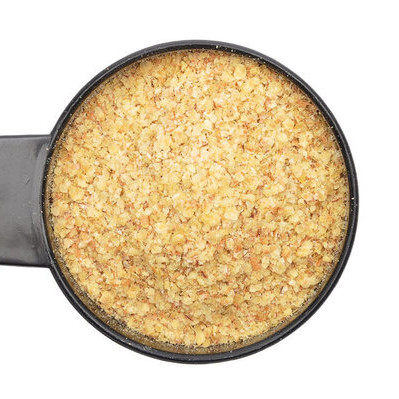Origin
Wheat (Triticum aestivum) is one of the oldest crops which dates back to the Stone Age. Its domestication started in the Tigris and Euphrates River Valley. 2 Today, China, India and the US are among the main producers of wheat in the world.2
Using this in baked goods is fairly recent and is associated with its added nutritional value. 2
Function
It is commonly added to baked goods for:1
- Flavor: provides a nutty flavor when toasted
- Texture: imparts a characteristic crunchy texture
- Binding: aids in water binding when partially substituted for flour
- Added nutritional value
Nutrition
Wheat germ nutritional value per 100g serving is:3
| Component | Grams |
|---|---|
| Carbohydrate | 53.33 |
| Protein | 26.67 |
| Water | 13.33 |
| Lipid | 6.67 |
This provides 400 kcal and 13.3 g fiber per 100 g serving. Consumption is associated with several health benefits such as: reduced risk of heart disease, weight control, cancer prevention, and lowering cholesterol.1,3
Commercial production
Wheat germ flakes are produced commercially using the following process: 1,2
- Cleaning: removal of foreign materials using a combination of blowing air and sieves.
- Tempering: moisture is adjusted to aid in the removal of the bran and germ from the endosperm.
- Crushing: corrugated rollers are used to break or crush the kernel to loosen the endosperm from the bran and germ.
- Separation: bran, germ and endosperm are separated using different size sieves.
For wheat germ flakes
- Dryng: crushed germ is dried in a roller drier to form the flakes.
- Enzyme deactivation
- Packaging: flakes are packed in bags and later stored.
Application
Similar to flaxseed, ground sunflower seed and oat bran, wheat germ can be added to several baked goods such as: breads, muffins, cookies and biscuits. At low substitution levels, it imparts desirable sensorial properties.1
Enriched baking flours can incorporate a maximum of 5% based on flour weight.5
Common usage levels and impact on baked goods:4
| Baked good | Usage level | Effect |
|---|---|---|
| Bread | At 50% wheat flour replacement |
|
| Cookies | At <15% substitution |
|
Regulations
Wheat germ is considered GRAS by the FDA, and it can be commonly used up to a 5% level to enriched wheat flour.5
In the EU, wheat germ is considered safe and its usage is regulated by the Organisation of Grain Markets established by the EU Commission 1308/2013.6
References
- Figoni, P. How Baking Works: Exploring The Fundamentals Of Baking Science. 3 rd ed., John Wiley & Sons, Inc., 2011, p.p 81 & 141.
- Mir, S. A., Manickavasagan, A and Shah,M.A .Whole Grains: Processing, Product Development, and Nutritional Aspects. 1 st ed., CRC press, 2019, p.p 238 – 250.
- U.S. Department of Agriculture, Agricultural Research Service. FoodData Central, 08 March 2020. https://fdc.nal.usda.gov/fdc-app.html#/food-details/1417024/nutrients . Accessed 04 March 2021.
- Paucean, A., S. M. Man, and S. A. Socaci. “Wheat germ bread quality and dough rheology as influenced by added enzymes and ascorbic acid.” Studia Universitatis Babes-Bolyai, Chemia 2016, 61 (2): 103-118.
- Food and Drug Administration (FDA). US Department of Health and Human Services. CFR Code of Federal Regulations Title 21, Part 126 Bakery Products, https://www.accessdata.fda.gov/scripts/cdrh/cfdocs/cfcfr/CFRSearch.cfm?fr=136.115 , Accessed 04 March 2021.
- European Commission (Ec). Commission Regulation (Eu) No 1308/2013 Of The European Parliament And Of The Council Of 17 December 2013 Establishing A Common Organisation Of The Markets In Agricultural Products And Repealing Council Regulations (Eec) No 922/72, (Eec) No 234/79, (Ec) No 1037/2001 And (Ec) No 1234/2007. Official Journal Of European Communities, 17 December 2013.

